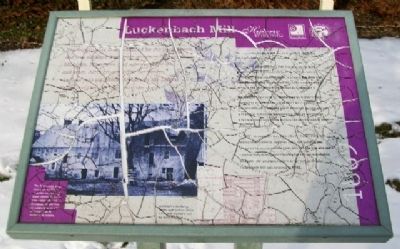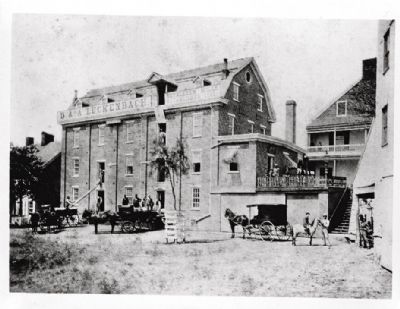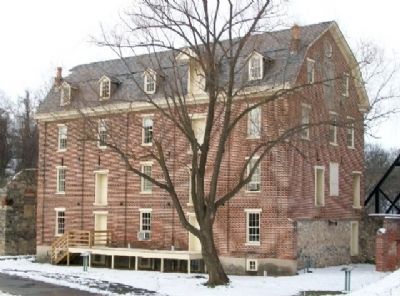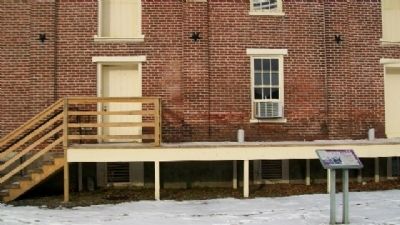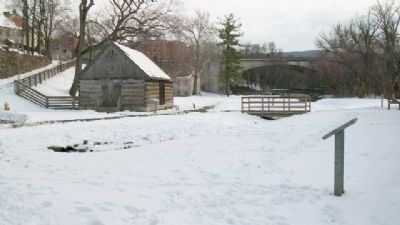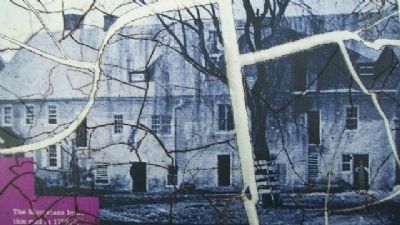Bethlehem in Lehigh County, Pennsylvania — The American Northeast (Mid-Atlantic)
Luckenbach Mill
1869
The high quality flour produced by the Luckenbach Mill was obtained from grain grown in Pennsylvania, Michigan, Minnesota, and other parts of the mid-west. After processing in Bethlehem, the flour was marketed throughout the Lehigh Valley and the coal regions to the north.
The current Luckenbach Mill was built in 1869 and is the third grist mill to occupy this location.
In 1743, the Moravians built their first grist mill to grind grain into flour. A second mill, built in 1751, included a fulling mill to process wool cloth.. In 1759, a dye shop and clothweavers shop were added. When this complex burned in 1869, the Luckenbach Mill immediately replaced it.
Waterwheels turned by the Monocacy Creek powered the equipment in these mills. Creek water was dammed and directed through a raceway where it entered the mill through a headrace, turned the waterwheels, then exited through a tailrace. Remnants of the tailrace can still be seen in front of the nearby tannery.
In 1877, steampower was added to the Luckenbach Mill. Milling ended here in 1949. In 1952, the building was occupied by an automobile parts and salvage firm and the Colonial Industrial Quarter quickly became an automobile junkyard. The area was cleared in the 1960s and the Luckenbach Mill was restored in 1982.
[Caption for photo on marker]
The Moravians built this mill in 1751. It was two stories high with limestone walls and a clay tile roof. It contained one run of millstones. In 1752, a second run of stones was added.
[Marker is damaged]
Erected by Historic Bethlehem, HistoryWorks!, and Delaware & Lehigh National Heritage Corridor.
Topics. This historical marker is listed in these topic lists: Colonial Era • Industry & Commerce • Man-Made Features • Natural Resources • Notable Buildings • Waterways & Vessels. A significant historical year for this entry is 1869.
Location. 40° 37.219′ N, 75° 23.009′ W. Marker is in Bethlehem, Pennsylvania, in Lehigh County. Marker is in the Colonial Industrial Quarter of Historic Bethlehem, along the former Old York Road, about 150 feet east of the old stone bridge over the Monocacy Creek. Touch for map. Marker is in this post office area: Bethlehem PA 18018, United States of America. Touch for directions.
Other nearby markers. At least 8 other markers are within walking distance of this marker. Butchery (a few steps from this marker); Miller's House (a few steps from this marker); Dye House (a few steps from this marker); Tannery (within shouting distance of this marker); Springhouse (within shouting
distance of this marker); Tawery (within shouting distance of this marker); Bark Shed (about 400 feet away, measured in a direct line); First House of Moravian Settlement (about 400 feet away). Touch for a list and map of all markers in Bethlehem.
Also see . . .
1. Colonial Industrial Quarter. (Submitted on February 1, 2010, by William Fischer, Jr. of Scranton, Pennsylvania.)
2. Luckenbach Flour Mill. Historical American Buildings Survey record for the Luckenbach Flour Mill. Includes photo, architectural drawings, and a history of the building. (Submitted on December 14, 2014.)
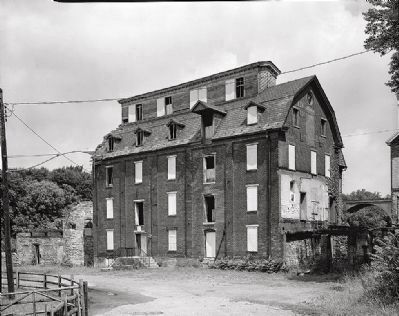
Historic American Buildings Survey
3. Luckenbach Mill - Awaiting Restoration
HABS statement of significance: Located on the foundation of a 1751 Moravian grist mill, the Luckenbach Flour Mill represents the evolution of milling technology in the last half of the 19th century. Roller milling machinery was installed in 1882.
Credits. This page was last revised on October 6, 2020. It was originally submitted on February 1, 2010, by William Fischer, Jr. of Scranton, Pennsylvania. This page has been viewed 1,279 times since then and 28 times this year. Photos: 1. submitted on February 1, 2010, by William Fischer, Jr. of Scranton, Pennsylvania. 2, 3. submitted on December 14, 2014. 4, 5, 6, 7. submitted on February 1, 2010, by William Fischer, Jr. of Scranton, Pennsylvania.
